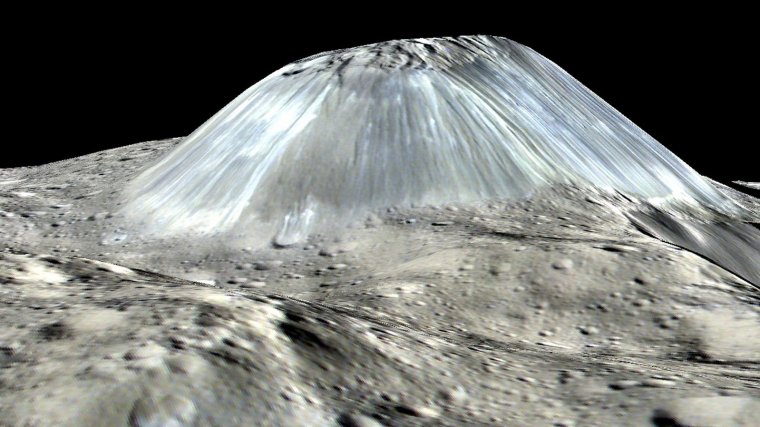| News / Science News |
Ceres' Geological Activity, Ice Revealed in New Research
NASA | SEPTEMBER 4, 2016
A lonely 3-mile-high (5-kilometer-high) mountain on Ceres is likely volcanic in origin, and the dwarf planet may have a weak, temporary atmosphere.

Ceres' lonely mountain, Ahuna Mons, is seen in this simulated perspective view. The elevation has been exaggerated by a factor of two. ![]()
NASA's Dawn mission may have detected a weak, temporary atmosphere. Dawn's gamma ray and neutron (GRaND) detector observed evidence that Ceres had accelerated electrons from the solar wind to very high energies over a period of about six days. In theory, the interaction between the solar wind's energetic particles and atmospheric molecules could explain the GRaND observations.
A temporary atmosphere would be consistent with the water vapor the Herschel Space Observatory detected at Ceres in 2012-2013. The electrons that GRaND detected could have been produced by the solar wind hitting the water molecules that Herschel observed, but scientists are also looking into alternative explanations.
Ahuna Mons is a volcanic dome unlike any seen elsewhere in the solar system, according to a new analysis led by Ottaviano Ruesch of NASA's Goddard Space Flight Center, Greenbelt, Maryland, and the Universities Space Research Association.
The lonely mountain is likely volcanic in nature. Specifically, it would be a cryovolcano -- a volcano that erupts a liquid made of volatiles such as water, instead of silicates. This is the only known example of a cryovolcano that potentially formed from a salty mud mix, and that formed in the geologically recent past.
While Ahuna Mons may have erupted liquid water in the past, Dawn has detected water in the present. Exposed water-ice is rare on Ceres, but the low density of Ceres, the impact-generated flows and the very existence of Ahuna Mons suggest that Ceres' crust does contain a significant component of water-ice.
The dwarf planet's various crater forms are consistent with an outer shell for Ceres that is not purely ice or rock, but rather a mixture of both -- a conclusion reflected in other analyses.
Scientists also calculated the ratio of various craters' depths to diameters, and found that some amount of crater relaxation must have occurred. Additionally, there are more craters in the northern hemisphere of Ceres than the south, where the large Urvara and Yalode craters are the dominant features.
The uneven distribution of craters indicates that the crust is not uniform, and that Ceres has gone through a complex geological evolution.
A study led by Eleonora Ammannito of the University of California, Los Angeles, finds that clay-forming minerals called phyllosilicates are all over Ceres.
These phyllosilicates are rich in magnesium and also have some ammonium embedded in their crystalline structure. Their distribution throughout the dwarf planet's crust indicates Ceres' surface material has been altered by a global process involving water.
YOU MAY ALSO LIKE



